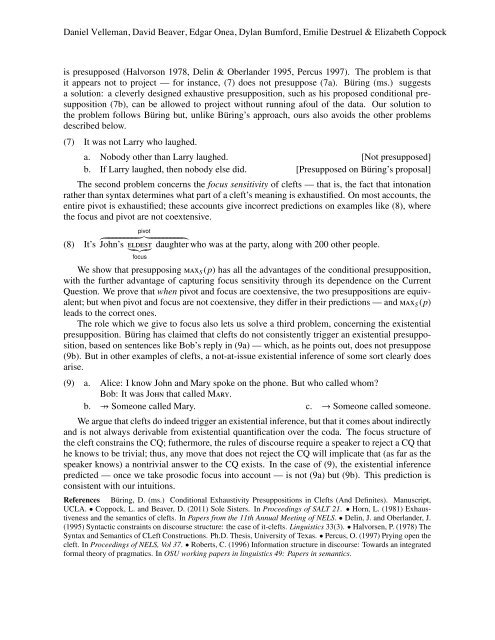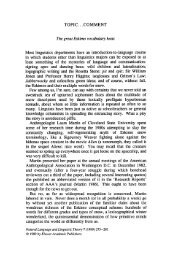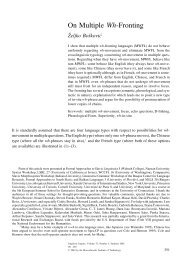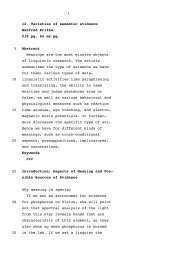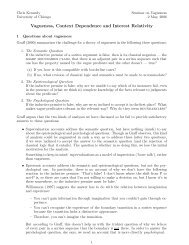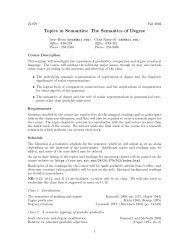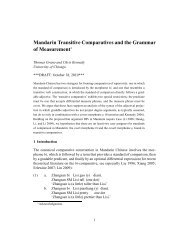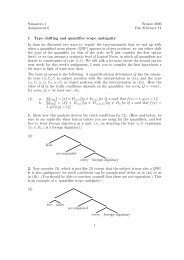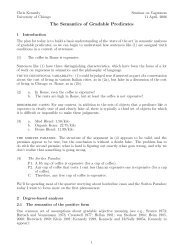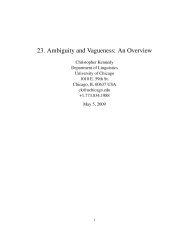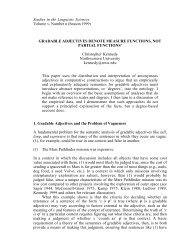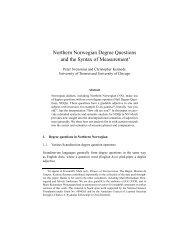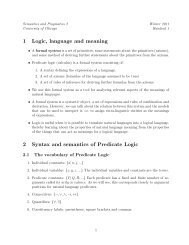On the natural history of negative polarity items - Syntax, Semantics ...
On the natural history of negative polarity items - Syntax, Semantics ...
On the natural history of negative polarity items - Syntax, Semantics ...
Create successful ePaper yourself
Turn your PDF publications into a flip-book with our unique Google optimized e-Paper software.
Daniel Velleman, David Beaver, Edgar <strong>On</strong>ea, Dylan Bumford, Emilie Destruel & Elizabeth Coppock<br />
is presupposed (Halvorson 1978, Delin & Oberlander 1995, Percus 1997). The problem is that<br />
it appears not to project — for instance, (7) does not presuppose (7a). Büring (ms.) suggests<br />
a solution: a cleverly designed exhaustive presupposition, such as his proposed conditional presupposition<br />
(7b), can be allowed to project without running afoul <strong>of</strong> <strong>the</strong> data. Our solution to<br />
<strong>the</strong> problem follows Büring but, unlike Büring’s approach, ours also avoids <strong>the</strong> o<strong>the</strong>r problems<br />
described below.<br />
(7) It was not Larry who laughed.<br />
a. Nobody o<strong>the</strong>r than Larry laughed. [Not presupposed]<br />
b. If Larry laughed, <strong>the</strong>n nobody else did. [Presupposed on Büring’s proposal]<br />
The second problem concerns <strong>the</strong> focus sensitivity <strong>of</strong> clefts — that is, <strong>the</strong> fact that intonation<br />
ra<strong>the</strong>r than syntax determines what part <strong>of</strong> a cleft’s meaning is exhaustified. <strong>On</strong> most accounts, <strong>the</strong><br />
entire pivot is exhaustified; <strong>the</strong>se accounts give incorrect predictions on examples like (8), where<br />
<strong>the</strong> focus and pivot are not coextensive.<br />
(8) It’s<br />
pivot<br />
z }| {<br />
John’s eldest | {z } daughter who was at <strong>the</strong> party, along with 200 o<strong>the</strong>r people.<br />
focus<br />
We show that presupposing maxS (p) has all <strong>the</strong> advantages <strong>of</strong> <strong>the</strong> conditional presupposition,<br />
with <strong>the</strong> fur<strong>the</strong>r advantage <strong>of</strong> capturing focus sensitivity through its dependence on <strong>the</strong> Current<br />
Question. We prove that when pivot and focus are coextensive, <strong>the</strong> two presuppositions are equivalent;<br />
but when pivot and focus are not coextensive, <strong>the</strong>y di er in <strong>the</strong>ir predictions — and maxS (p)<br />
leads to <strong>the</strong> correct ones.<br />
The role which we give to focus also lets us solve a third problem, concerning <strong>the</strong> existential<br />
presupposition. Büring has claimed that clefts do not consistently trigger an existential presupposition,<br />
based on sentences like Bob’s reply in (9a) — which, as he points out, does not presuppose<br />
(9b). But in o<strong>the</strong>r examples <strong>of</strong> clefts, a not-at-issue existential inference <strong>of</strong> some sort clearly does<br />
arise.<br />
(9) a. Alice: I know John and Mary spoke on <strong>the</strong> phone. But who called whom?<br />
Bob: It was John that called Mary.<br />
b. 9 Someone called Mary. c. ⇥ Someone called someone.<br />
We argue that clefts do indeed trigger an existential inference, but that it comes about indirectly<br />
and is not always derivable from existential quantification over <strong>the</strong> coda. The focus structure <strong>of</strong><br />
<strong>the</strong> cleft constrains <strong>the</strong> CQ; fu<strong>the</strong>rmore, <strong>the</strong> rules <strong>of</strong> discourse require a speaker to reject a CQ that<br />
he knows to be trivial; thus, any move that does not reject <strong>the</strong> CQ will implicate that (as far as <strong>the</strong><br />
speaker knows) a nontrivial answer to <strong>the</strong> CQ exists. In <strong>the</strong> case <strong>of</strong> (9), <strong>the</strong> existential inference<br />
predicted — once we take prosodic focus into account — is not (9a) but (9b). This prediction is<br />
consistent with our intuitions.<br />
References Büring, D. (ms.) Conditional Exhaustivity Presuppositions in Clefts (And Definites). Manuscript,<br />
UCLA. • Coppock, L. and Beaver, D. (2011) Sole Sisters. In Proceedings <strong>of</strong> SALT 21. • Horn, L. (1981) Exhaustiveness<br />
and <strong>the</strong> semantics <strong>of</strong> clefts. In Papers from <strong>the</strong> 11th Annual Meeting <strong>of</strong> NELS. • Delin, J. and Oberlander, J.<br />
(1995) Syntactic constraints on discourse structure: <strong>the</strong> case <strong>of</strong> it-clefts. Linguistics 33(3). • Halvorsen, P. (1978) The<br />
<strong>Syntax</strong> and <strong>Semantics</strong> <strong>of</strong> CLeft Constructions. Ph.D. Thesis, University <strong>of</strong> Texas. • Percus, O. (1997) Prying open <strong>the</strong><br />
cleft. In Proceedings <strong>of</strong> NELS, Vol 37. • Roberts, C. (1996) Information structure in discourse: Towards an integrated<br />
formal <strong>the</strong>ory <strong>of</strong> pragmatics. In OSU working papers in linguistics 49: Papers in semantics.


